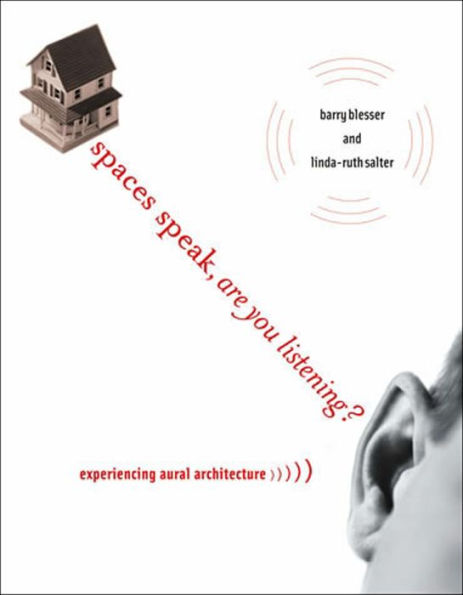
Spaces Speak, Are You Listening?: Experiencing Aural Architecture
456
Spaces Speak, Are You Listening?: Experiencing Aural Architecture
456eBook
Related collections and offers
Overview
We experience spaces not only by seeing but also by listening. We can navigate a room in the dark, and "hear" the emptiness of a house without furniture. Our experience of music in a concert hall depends on whether we sit in the front row or under the balcony. The unique acoustics of religious spaces acquire symbolic meaning. Social relationships are strongly influenced by the way that space changes sound. In Spaces Speak, Are You Listening?, Barry Blesser and Linda-Ruth Salter examine auditory spatial awareness: experiencing space by attentive listening. Every environment has an aural architecture.The audible attributes of physical space have always contributed to the fabric of human culture, as demonstrated by prehistoric multimedia cave paintings, classical Greek open-air theaters, Gothic cathedrals, acoustic geography of French villages, modern music reproduction, and virtual spaces in home theaters. Auditory spatial awareness is a prism that reveals a culture's attitudes toward hearing and space. Some listeners can learn to "see" objects with their ears, but even without training, we can all hear spatial geometry such as an open door or low ceiling.
Integrating contributions from a wide range of disciplines—including architecture, music, acoustics, evolution, anthropology, cognitive psychology, audio engineering, and many others—Spaces Speak, Are You Listening? establishes the concepts and language of aural architecture. These concepts provide an interdisciplinary guide for anyone interested in gaining a better understanding of how space enhances our well-being. Aural architecture is not the exclusive domain of specialists. Accidentally or intentionally, we all function as aural architects.

Product Details
| ISBN-13: | 9780262250702 |
|---|---|
| Publisher: | MIT Press |
| Publication date: | 09/18/2009 |
| Series: | The MIT Press |
| Sold by: | Penguin Random House Publisher Services |
| Format: | eBook |
| Pages: | 456 |
| File size: | 3 MB |
| Age Range: | 18 Years |
About the Author
Linda-Ruth Salter, Ph.D., is an independent scholar who has spent the last 25 years focusing on the interdisciplinary relationship of art, space, culture, and technology.
What People are Saying About This
Blesser and Salter have thoughtfully synthesized a wide range of technical, aesthetic, and humanistic considerations of aural architecture to create a valuable interdisciplinary resource for anyone interested in thinking about sound, space, and society.
The 'final frontier' of computer music is undoubtedly microsound—the quantum level of acoustics—and Curtis Roads boldly leads us into this new domain, which will become increasingly important in the 21st century. In providing the history, theory, and compositional practice of the micro scale of sound design, Roads clearly lays out the roadmap to this exciting and challenging area of digital research. The book is destined to become the standard reference in the field for years to come.
At last, a book that reveals that spaces are meaningful beyond their acoustics! I was captivated by this impressively well-documented book, and recommend it to anyone with an interest in acoustics or architecture.
The 'final frontier' of computer music is undoubtedly microsound—the quantum level of acoustics—and Curtis Roads boldly leads us into this new domain, which will become increasingly important in the 21st century. In providing the history, theory, and compositional practice of the micro scale of sound design, Roads clearly lays out the roadmap to this exciting and challenging area of digital research. The book is destined to become the standard reference in the field for years to come.
—Barry Truax, Professor and Composer, Simon Fraser University
At last, a book that reveals that spaces are meaningful beyond their acoustics! I was captivated by this impressively well-documented book, and recommend it to anyone with an interest in acoustics or architecture.
—Jean-Dominique Polack, Université Pierre et Marie Curie, ParisBlesser and Salter have thoughtfully synthesized a wide range of technical, aesthetic, and humanistic considerations of aural architecture to create a valuable interdisciplinary resource for anyone interested in thinking about sound, space, and society.
—Emily Thompson, Professor of History, Princeton University, and author of The Soundscape of Modernity: Architectural Acoustics and the Culture of Listening in America, 1900-1933This wide-ranging, articulate, and probing investigation of how humans listen helps us to appreciate the value of natural and constructed acoustics. It also shows that our sense of the space of sound has largely been lost in the vast library of recorded music. This book will change how you listen. Well done!
—Floyd Toole, Vice President of Acoustical Engineering, Harman International IndustriesThis book is a serious overview of aural architecture and its growing importance in our world. Its comprehensive range - from historical essay to technical and social aspects of the field - makes it an important addition to the existing literature on this subject.
—Karen Van Lengen, Dean, School of Architecture, University of VirginiaThis wide-ranging, articulate, and probing investigation of how humans listen helps us to appreciate the value of natural and constructed acoustics. It also shows that our sense of the space of sound has largely been lost in the vast library of recorded music. This book will change how you listen. Well done!
This book is a serious overview of aural architecture and its growing importance in our world. Its comprehensive range - from historical essay to technical and social aspects of the field - makes it an important addition to the existing literature on this subject.
